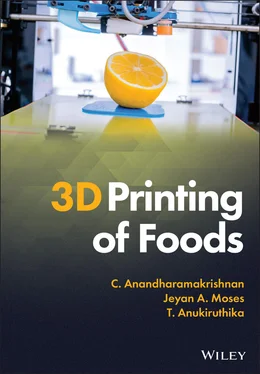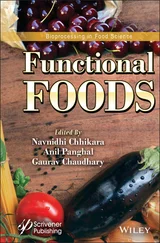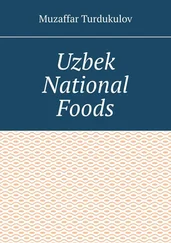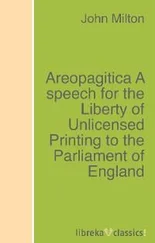C. Anandharamakrishnan - 3D Printing of Foods
Здесь есть возможность читать онлайн «C. Anandharamakrishnan - 3D Printing of Foods» — ознакомительный отрывок электронной книги совершенно бесплатно, а после прочтения отрывка купить полную версию. В некоторых случаях можно слушать аудио, скачать через торрент в формате fb2 и присутствует краткое содержание. Жанр: unrecognised, на английском языке. Описание произведения, (предисловие) а так же отзывы посетителей доступны на портале библиотеки ЛибКат.
- Название:3D Printing of Foods
- Автор:
- Жанр:
- Год:неизвестен
- ISBN:нет данных
- Рейтинг книги:3 / 5. Голосов: 1
-
Избранное:Добавить в избранное
- Отзывы:
-
Ваша оценка:
- 60
- 1
- 2
- 3
- 4
- 5
3D Printing of Foods: краткое содержание, описание и аннотация
Предлагаем к чтению аннотацию, описание, краткое содержание или предисловие (зависит от того, что написал сам автор книги «3D Printing of Foods»). Если вы не нашли необходимую информацию о книге — напишите в комментариях, мы постараемся отыскать её.
Explore the fascinating realm of 3D food printing and its applications 3D Printing of Foods
3D Printing of Foods
3D Printing of Foods
3D Printing of Foods — читать онлайн ознакомительный отрывок
Ниже представлен текст книги, разбитый по страницам. Система сохранения места последней прочитанной страницы, позволяет с удобством читать онлайн бесплатно книгу «3D Printing of Foods», без необходимости каждый раз заново искать на чём Вы остановились. Поставьте закладку, и сможете в любой момент перейти на страницу, на которой закончили чтение.
Интервал:
Закладка:
Basic mechanisms responsible for the gelation of hydrogels are ionotropic cross‐linking, chemical cross‐linking and coacervate formation. Among which ionotropic cross‐linking is the most commonly employed technique for hydrogel formation. The physiochemical characteristics of the hydrocolloids were greatly affected by several factors such as temperature, melting and solidification, ionic strength, gelation behaviour, and cross‐linking (Godoi et al. 2016). Hydrocolloids in the form of hydrogels are gaining attention in recent days as it possesses the centric value as that of dietary fibres. A study was reported on the satiety effects of hydrocolloids, as it could result in slowing down of enzymatic actions or could delay gastric emptying (Li and Nie 2016). As an important application, hydrocolloids are utilized for increasing the fibre content of the diet. Along with other major food constituents, hydrocolloids play a significant role in modifying the sensorial aspects of food and hence found to possess a key role in regulating the dietary aspects of food for providing a healthy 3D printed customized diet.
3.5 Classification of Foods Based on Their Printability
The nature of the material supply is an essential criterion in determining the final quality of the 3D printed edible constructs. Printability refers to the inherent ability of the material to withstand its own weight upon deposition over the printing platform (Kim et al. 2018). A material to possess good printability must have enough dimensional and mechanical stability to retain its shape after printing. Based on the nature and printability of the material supply, the ingredients for 3D printing can be categorized as natively printable, non‐printable traditional materials and alternative ingredients (Sun et al. 2018). The first class of natively printable materials include chocolates, cheese, cake frostings, hydrogels, etc., which are innately printable on their own without the addition of additives. This class of material supply requires less processing with ease of handling during printing. A second class of traditional materials includes staple cereals, fruits and vegetables, eggs and flesh foods that are common in our day‐to‐day life but are non‐printable on its own. This kind of material requires certain pre‐processing such as the addition of food additives or mixing a proportionate amount of natively printable materials for converting them into a printable form. The most common application is the use of food hydrocolloids as additives for making non‐printable materials printable. The third category includes alternate ingredients like insects, algae, fungi, and lupin seeds which are quite a good source of nutrients but are uncommon foods (Sun et al. 2015). They are widely used as a novel approach for the development of sustainable food to tackle the ever‐growing food demand. A detailed description of the classification of materials based on printability was discussed in the subsequent chapters.
3.6 Conclusion
Food 3D printing implies a novel way of customizing foods based on individual preferences. The final acceptability of any food recipe was based on the ingredient’s choice that makes a wholesome food. The role of various food constituents in terms of printing was well discussed in the present chapter. The chemical and structural constituents responsible for the printability of macronutrients provides insights for the development of 3D printed functional foods based on age group and dietary pattern. The study of the individual food constituent and its response towards printability helps to combine the ingredients that pave for the exploration of new dishes by utilizing the synergistic benefits of each constituent. Thus, apart from the nutritional benefits, each of the macro elements of food has its role in imparting printability and acts as a key in modifying the sensorial attributes of food.
References
1 Amicucci, M.J., Nandita, E., and Lebrilla, C.B. (2019). Function without structures: the need for in‐depth analysis of dietary carbohydrates. Journal of Agricultural and Food Chemistry 67 (16): 4418–4424.
2 Anukiruthika, T., Moses, J.A., and Anandharamakrishnan, C. (2020). 3D printing of egg yolk and white with rice flour blends. Journal of Food Engineering 265: 109691. https://doi.org/10.1016/j.jfoodeng.2019.109691.
3 Chen, J., Mu, T., Goffin, D. et al. (2019). Application of soy protein isolate and hydrocolloids based mixtures as promising food material in 3D food printing. Journal of Food Engineering 261: 76–86. https://doi.org/10.1016/j.jfoodeng.2019.03.016.
4 Dai, F.‐J. and Chau, C.‐F. (2017). Classification and regulatory perspectives of dietary fiber. Journal of Food and Drug Analysis 25 (1): 37–42.
5 Devi, A. and Khatkar, B.S. (2016). Physicochemical, rheological and functional properties of fats and oils in relation to cookie quality: a review. Journal of Food Science and Technology 53 (10): 3633–3641.
6 Dick, A., Bhandari, B., and Prakash, S. (2019). Post‐processing feasibility of composite‐layer 3D printed beef. Meat Science 153: 9–18. https://doi.org/10.1016/j.meatsci.2019.02.024.
7 Dong, X., Huang, Y., Pan, Y. et al. (2019). Investigation of sweet potato starch as structural enhancer for 3D printing of Scomberomorus niphonius surimi. Journal of Texture Studies 50: 316–324. https://doi.org/10.1111/jtxs.12398.
8 Godoi, F.C., Prakash, S., and Bhandari, B.R. (2016). 3d printing technologies applied for food design: status and prospects. Journal of Food Engineering 179: 44–54.
9 Godoi, F.C., Bhandari, B.R., Prakash, S., and Zhang, M. (2019). An introduction to the principles of 3D food printing. In: Fundamentals of 3D Food Printing and Applications (eds. F.C. Godoi, B.R. Bhandari, S. Prakash and M. Zhang), pp. 1–18. Elsevier.
10 Hoffman, J.R. (2019). Dietary Supplementation in Sport and Exercise: Evidence, Safety and Ergogenic Benefits. Routledge.
11 Huang, M., Zhang, M., and Bhandari, B. (2019). Assessing the 3D printing precision and texture properties of brown rice induced by infill levels and printing variables. Food and Bioprocess Technology 12: 1–12. https://doi.org/10.1007/s11947‐019‐02287‐x.
12 Kim, H.W., Bae, H., and Park, H.J. (2018). Classification of the printability of selected food for 3D printing: development of an assessment method using hydrocolloids as reference material. Journal of Food Engineering 215: 23–32.
13 Krishnaraj, P., Anukiruthika, T., Choudhary, P. et al. (2019). 3D extrusion printing and post‐processing of fibre‐rich snack from indigenous composite flour. Food and Bioprocess Technology 12 (10): 1776–1786. https://doi.org/10.1007/s11947‐019‐02336‐5.
14 Lanaro, M., Desselle, M.R., and Woodruff, M.A. (2019). 3D printing chocolate: properties of formulations for extrusion, sintering, binding and ink jetting. In: Fundamentals of 3D Food Printing and Applications (eds. F.C. Godoi, B.R. Bhandari, S. Prakash and M. Zhang), pp. 151–173. United Kingdom: Academic Press.
15 Lassé, M., Deb‐Choudhury, S., Haines, S. et al. (2015). The impact of pH, salt concentration and heat on digestibility and amino acid modification in egg white protein. Journal of Food Composition and Analysis 38: 42–48.
16 Le Tohic, C., O’Sullivan, J.J., Drapala, K.P. et al. (2018). Effect of 3D printing on the structure and textural properties of processed cheese. Journal of Food Engineering 220: 56–64.
17 Lee, J.H., Won, D.J., Kim, H.W., and Park, H.J. (2019). Effect of particle size on 3D printing performance of the food‐ink system with cellular food materials. Journal of Food Engineering 256: 1–8. https://doi.org/10.1016/j.jfoodeng.2019.03.014.
18 Li, J.‐M. and Nie, S.‐P. (2016). The functional and nutritional aspects of hydrocolloids in foods. Food Hydrocolloids 53: 46–61.
Читать дальшеИнтервал:
Закладка:
Похожие книги на «3D Printing of Foods»
Представляем Вашему вниманию похожие книги на «3D Printing of Foods» списком для выбора. Мы отобрали схожую по названию и смыслу литературу в надежде предоставить читателям больше вариантов отыскать новые, интересные, ещё непрочитанные произведения.
Обсуждение, отзывы о книге «3D Printing of Foods» и просто собственные мнения читателей. Оставьте ваши комментарии, напишите, что Вы думаете о произведении, его смысле или главных героях. Укажите что конкретно понравилось, а что нет, и почему Вы так считаете.










